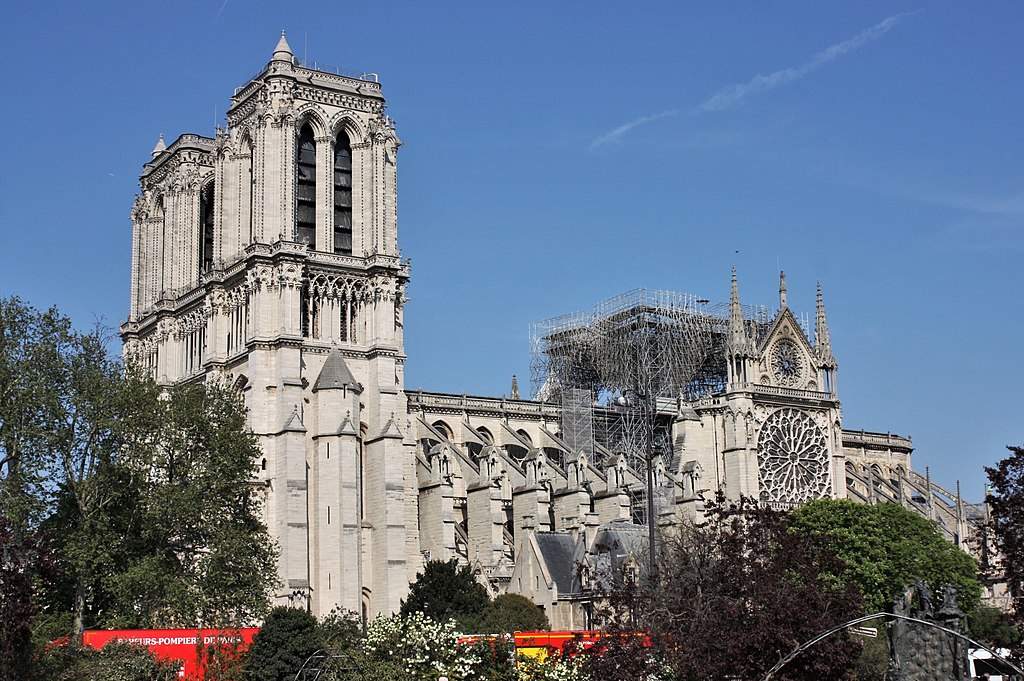Paris, 100 intellectuals sign against Notre-Dame redevelopment project
In France, a hundred intellectuals and cultural figures signed a petition, published simultaneously in Le Figaro and La Tribune de l’Art, against the Notre-Dame Cathedral redevelopment project. The project concerns the interior of the cathedral, which, moreover, was largely spared by the ruinous fire that devastated the building’s roofs on April 15, 2019. The project will be officially presented today, Dec. 9, at the headquarters of the Commission nationale du patrimoine et de l’architecture (CNPA), and will mainly concern the furnishings (there will be contemporary installations), the lighting system, which will be rethought and will see the use of projections, and the visit route.
The project, drawn up by the Archdiocese of Paris under the direction of Gilles Drouin, director of the Institut supérieur de liturgie de l’Institut catholique de Paris, will have to be approved by the CNPA. But all the French newspapers in recent days predicted that it would cause much discussion, since Drouin’s team’s plan includes radical changes: for example, the installation of a new baptismal font in the center of the nave and the presence of contemporary artworks in the aisles. And so many have raised eyebrows considering it a project disrespectful of the building’s history.
The resurrection of the cathedral, the petitioners write in their petition, “is seriously compromised by a project to enhance the interior of the monument. The diocese of Paris wants to exploit the restoration project to transform the interior of Notre-Dame in a project that completely disrupts the furnishings and liturgical space. It therefore believes that the destruction of the fire is an opportunity to transform the visitor’s understanding of the monument, even if it is limited to the roof and spire and has not destroyed anything of the heritage inside. These proposed changes involve furnishings, lighting, and the tour route. The authors of this project seek to set up another route, another experience of the monument, even though Notre-Dame already offers a route. To give just one example, the organization designed by Viollet-le-Duc is based on a principle of gradation of spaces that already existed at the end of the Middle Ages and that he restored. The first chapels have a basic decoration to allow a gradual ascent to the splendor of the chancel. And so on. Everything was carefully thought out and calibrated.”
What the Archdiocese of Paris would like, the petitioners explain, “reduces to nothing the concept patiently developed by Viollet-le-Duc. The project involves the installation of removable benches, lighting that changes with the seasons, video projections on the walls, etc., i.e., the same fashionable (and therefore already terribly unfashionable) mediating devices found in all ’immersive’ cultural projects where very often stupidity competes with kitsch. However, this tragic fire offers us an exceptional opportunity, an absolutely unique opportunity: the restoration of the Viollet-le-Duc decorations. We are indeed able to revive a coherent ensemble of great formal perfection. The brilliant architect, anxious to extend and complete the work of the builders of the Middle Ages, had planned a total work of art, bringing together architecture and decoration, painting and sculpture, cabinetry and goldsmithing, stained glass and lighting. Guided by a clear vision of an artistic and spiritual ideal, he had designed and built the Cathedral of Cathedrals.”
“We respect the work of Viollet-le-Duc, we respect the work of the artists and craftsmen who worked to offer us this jewel: simply, we respect the principles of the heritage of a historic monument,” the petitioners conclude. “This restoration project should allow us to rediscover the authenticity of the place and its experience, relocating the good works in the right places, in an overall harmony and coherence. France will be admired by all for being able to carry out a restoration that will return a sublime monument to the world. Our architects, our restorers and all the artistic professions will thus have, in the words of the President of the Republic, made Notre-Dame more beautiful than before the fire, that is to say, sublime exactly like the one bequeathed to us.”
Image: Notre-Dame after the fire
 |
| Paris, 100 intellectuals sign against Notre-Dame redevelopment project |
Warning: the translation into English of the original Italian article was created using automatic tools. We undertake to review all articles, but we do not guarantee the total absence of inaccuracies in the translation due to the program. You can find the original by clicking on the ITA button. If you find any mistake,please contact us.




























